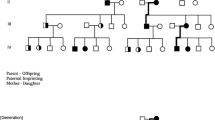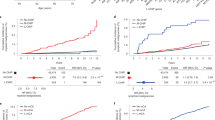Abstract
In order to monitor the clinical outcome of pediatric patients with leukemia following allogeneic hematopoietic transplantation, tests of variable number of tandem repeat (VNTR) and sex determination by quantitative polymerase chain reaction (PCR) were performed. PCR results combined with the blast counts from 21 leukemia patients were analyzed. Complete chimerism (100% donor cells) was found in 15 cases with remission, and incomplete chimerism in six cases with relapse. In the majority of cases, complete chimerism was always associated with no detectable blasts, while blasts were often detected in association with incomplete chimerism. There is significant correlation (P < 0.0001) between the percentage of donor DNA and blast percentage in these patients. Early detection of incomplete chimerism may therefore predict a poor prognosis. In one patient (case 15), a differing percentage of donor DNA was observed between samples of bone marrow and peripheral blood collected on the same day. This may be due to the fact that allogeneic stem cells proliferate at different rates depending on their environment (bone marrow or peripheral blood). In addition, 100% donor cells found in the peripheral blood may not reflect the number of cells in the bone marrow. In case 17, asynchronous engraftment of donor cells was present between the white and red blood cell lineages, indicating that the degree of chimerism may not be the same in all cell lineages. At the time of this report, the significance of this observation is unknown and needs further investigation.
Bone Marrow Transplantation (2002) 29, 51–56. doi:10.1038/sj.bmt.1703333
This is a preview of subscription content, access via your institution
Access options
Subscribe to this journal
Receive 12 print issues and online access
$259.00 per year
only $21.58 per issue
Buy this article
- Purchase on Springer Link
- Instant access to full article PDF
Prices may be subject to local taxes which are calculated during checkout




Similar content being viewed by others
References
Witherspoon RP, Schanfield MS, Storb R et al. Immunoglobulin production of donor origin after marrow transplantation for acute leukemia or aplastic anemia Transplantation 1978 26: 407 408
Gale RP, Sparkes RS, Golde DW . Bone marrow origin of hepatic macrophages (Kupffer cells) in humans Science 1978 201: 937 938
Borgaonkar DS, Bias WB, Sroka BM et al. Identification of graft and host cells in bone marrow transplants by the quinacrine banding technique of chromosome identification Acta Cytol 1974 18: 263 267
Blume KG, Beutler KJ, Bross KJ et al. Genetic markers in human bone marrow transplantation Am J Hum Genet 1980 32: 414 419
Ginsburg D, Antin JH, Smith BR et al. Origin of cell populations after bone marrow transplantation: analysis using DNA sequence polymorphisms J Clin Invest 1985 75: 596 603
Blazar BR, Orr HT, Arthur DC et al. Restriction fragment length polymorphisms as markers of engraftment in allogeneic marrow transplantation Blood 1985 66: 1436 1444
Knowlton RG, Brown VA, Braman JC et al. Use of highly polymorphic DNA probes for genotypic analysis following bone marrow transplantation Blood 1986 68: 378 385
Sreenan JJ, Pettay JD, Tbakhi A et al. The use of amplified variable number of tandem repeats (VNTR) in the detection of chimerism following bone marrow transplantation: a comparison with restriction fragment length polymorphism (RFLP) by southern blotting Am J Clin Pathol 1997 107: 292 298
Cui KH, Warnes GM, Jeffrey R, Matthews CD . Sex determination of preimplantation embryos by human testis-determining-gene amplification Lancet 1994 343: 79 82
Boerwinkle E, Xiong W, Fourest E, Chan L . Rapid typing of tandemly repeated hypervariable loci by the polymerase chain reaction: application to the apolipoprotein B 3′ hypervariable region Proc Natl Acad Sci USA 1989 86: 212 216
al-Nassar KE, Mathew J, Thomas N, Fatania HR . Analysis of the D1S80 (pMCT118) VNTR locus polymorphism in a native Kuwaiti population by the polymerase chain reaction Forensic Sci Int 1996 78: 131 138
Ugozzoli L, Yam P, Petz LD et al. Amplification by the polymerase chain reaction of hypervariable regions of the human genome for evaluation of chimerism after bone marrow transplantation Blood 1991 77: 1607 1615
Horn GT, Richards B, Klinger KW . Amplification of a highly polymorphic VNTR segment by the polymerase chain reaction Nucleic Acids Res 1989 17: 2140
Muniz ES, Plassa F, Amselem S et al. Molecular analysis of polymorphic loci to study chimerism after allogeneic bone marrow transplantation. Heteroduplex analysis in denaturing gradient gel electrophoresis: a new approach to detecting residual host cells Transplantation 1994 57: 451 456
Stuppia L, Calabrese G, Di Bartolomeo PD et al. Retrospective investigation of hematopoietic chimerism after BMT by PCR amplification of hypervariable DNA regions Cancer Genet Cytogenet 1995 85: 124 128
Bader P, Hölle W, Klingebiel T et al. Mixed hematopoietic chimerism after allogeneic bone marrow transplantation: the impact of quantitative PCR analysis for prediction of relapse and graft rejection in children Bone Marrow Transplant 1997 19: 697 702
Bader P, Beck J, Frey A et al. Serial and quantitative analysis of mixed hematopoietic chimerism by PCR in patients with acute leukemias allows the prediction of relapse after allogeneic BMT Bone Marrow Transplant 1998 21: 487 495
Gaiger A, Mannhalter C, Hinterberger W et al. Detection of engraftment and mixed chimerism following bone marrow transplantation using PCR amplification of a highly variable region-variable number of tandem repeats (VNTR) in the von Willebrand factor gene Ann Hematol 1991 63: 227 228
Scharf SJ, Smith AG, Hansen JA et al. Quantitative determination of bone marrow transplant engraftment using fluorescent polymerase chain reaction primers for human identity markers Blood 1995 85: 1954 1963
Acknowledgements
The authors would like to acknowledge Kelly Coyne, CPNP, Karen Smith, CPNP, and . Marie Olszewski of the Children's Memorial Hospital Stem Cell Transplant team for their contribution to this study.
Author information
Authors and Affiliations
Rights and permissions
About this article
Cite this article
Wang, LJ., Chou, P., Gonzalez-Ryan, L. et al. Evaluation of mixed hematopoietic chimerism in pediatric patients with leukemia after allogeneic stem cell transplantation by quantitative PCR analysis of variable number of tandem repeat and testis determination gene. Bone Marrow Transplant 29, 51–56 (2002). https://doi.org/10.1038/sj.bmt.1703333
Received:
Accepted:
Published:
Issue Date:
DOI: https://doi.org/10.1038/sj.bmt.1703333
Keywords
This article is cited by
-
Age-dependent pharmacokinetic profile of single daily dose i.v. busulfan in children undergoing reduced-intensity conditioning stem cell transplant
Bone Marrow Transplantation (2009)
-
Platelet chimerism by polymerase chain reaction (PCR) utilizing variable number of tandem repeats (VNTR) in allogeneic stem cell transplant in children: a new novel approach to full chimerism analysis
Bone Marrow Transplantation (2003)



